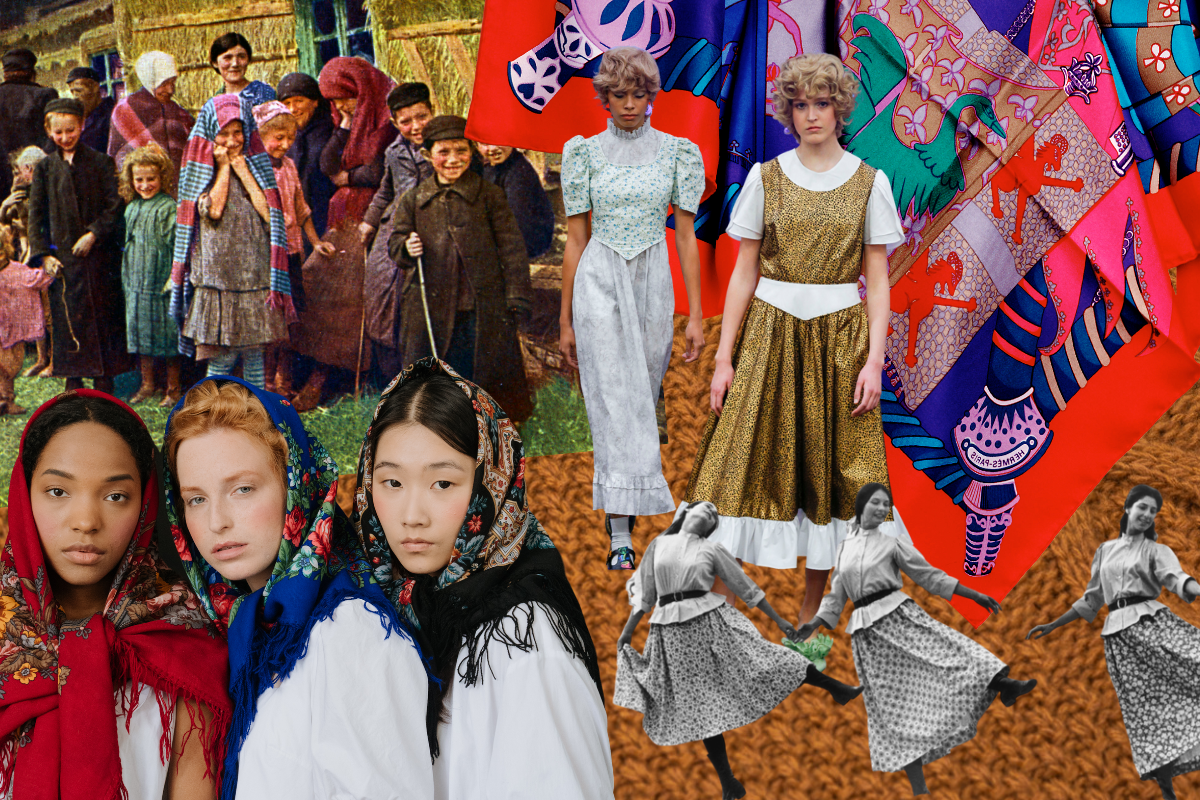With another summer gone by and “Coastal Bubbe” season officially behind us, it’s time to trade those crisp linen pants for pans of home-cooked apple crisp. Before we yearned for the cinematic joys of Nora Ephron Autumn and the homespun comforts of cottagecore, fall was a time for the Jews of Eastern Europe to trot out their show-stopping schmattes and shawls, bubbe-worthy babushkas and gatkes (aka long johns) galore. This, dear readers, is the essence of what I’ve dubbed Shtetlcore Fall.
Woven into the fabric of our Jewish customs and costumes is an ode to tradition and diaspora, immigration and assimilation, extended mishpacha and individual chutzpah. Dress is a way of fashioning identity, of telling stories. (We’re not fussy. Just give us a sturdy, preferably schmutz and schvitz-proof material to withstand 40 years of schlepping in the wilderness, and maybe a couple of pockets to store a siddur or a little nosh.) Every time we don an item of clothing, whether religious or secular, we’re honoring the threads that tie our community together, from generation to generation.
In the year 5783/2022, contemporary Jews and non-Jews across the globe are reviving Old World Ashkenazi style along with the Yiddish language. But don’t just take our word for it. We asked Jason Diamond, author, Jewish pop culture maven and contributor to GQ: Is Shtetlcore a thing?
“I think so!” he said. “I started getting my hopes up a few years ago when A$AP Rocky came out with Babushka Boi and started covering his head with Hermès scarves. I wouldn’t say we’re in Sholem Aleichem territory just yet, but we’re not far off. Everybody I know that wears dresses is looking to cop something from Batsheva and I’ve personally always said Tevye is a style icon, so if it isn’t a thing yet it definitely could be.”
You read it here first. We’re bringing the shtetl back, bubbeleh!
For your Shtetlcore Fall lookbook, we’ve gathered some of the most iconic shtetl fashion moments from Jewish cinema and television of the last century, from Yente to Yentl to Grandma Yetta and more.
“The Dybbuk” (1937)
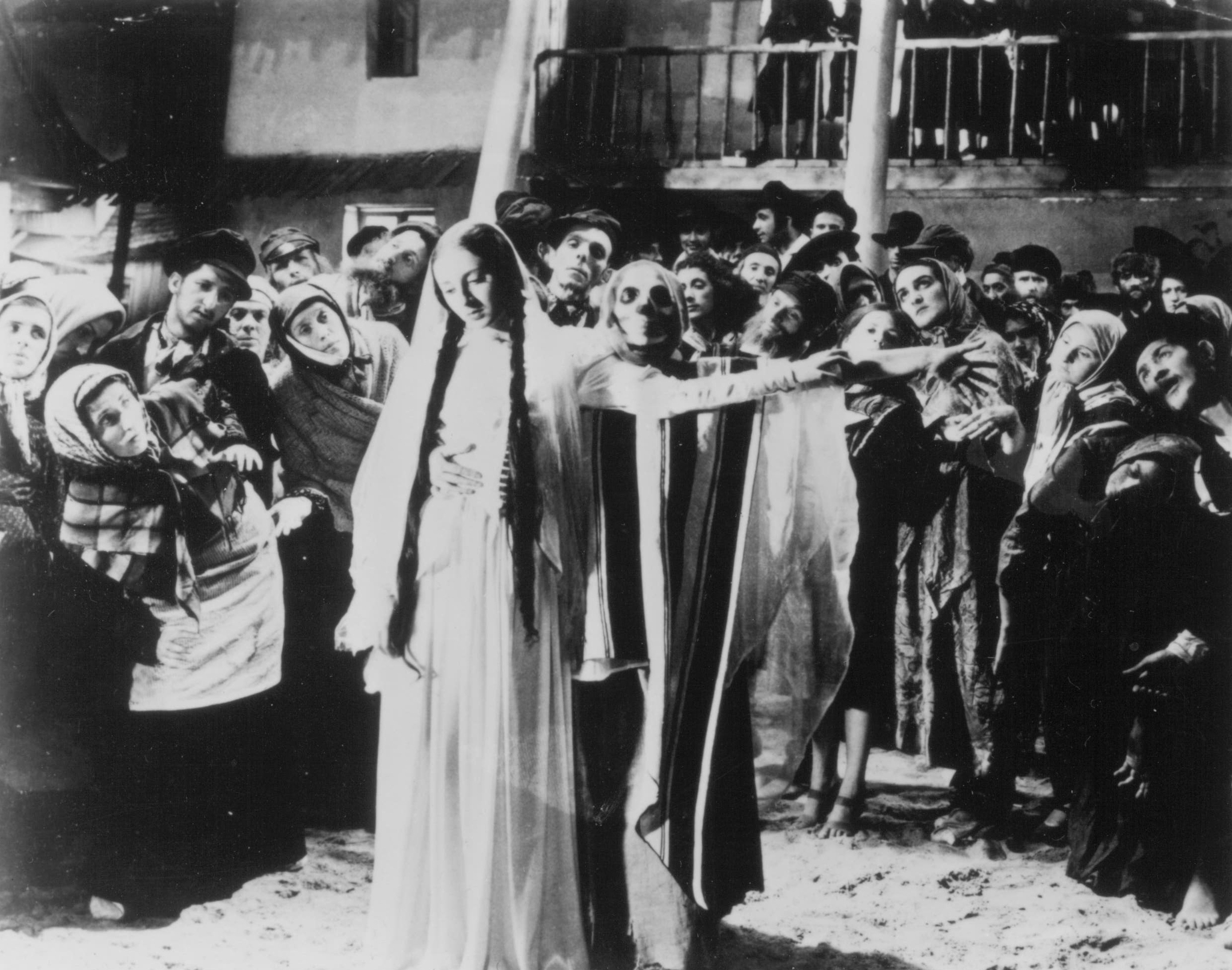
Based on the play by renowned folklorist and writer S. Ansky, this supernatural Yiddish language film brings epic Shtetlcore vibes. It’s the perfect launch pad for those who like their autumnal attire with a tinge of gothic drama and romance of the star-crossed variety. We’re talking superstitious villagers in full beards and fur-trimmed hats, a satanic yeshiva student in scholarly garb, a possessed bride with Wednesday Addams-style braids and a knitted shawl that could double as a vampire cape, draped over a sumptuous and ghostly long-sleeved white gown. These looks are downright operatic. If you thought the wedding/graveyard dream sequence in “Fiddler on the Roof” was eerie, think again. Which brings us to…
“Fiddler on the Roof” (1971)
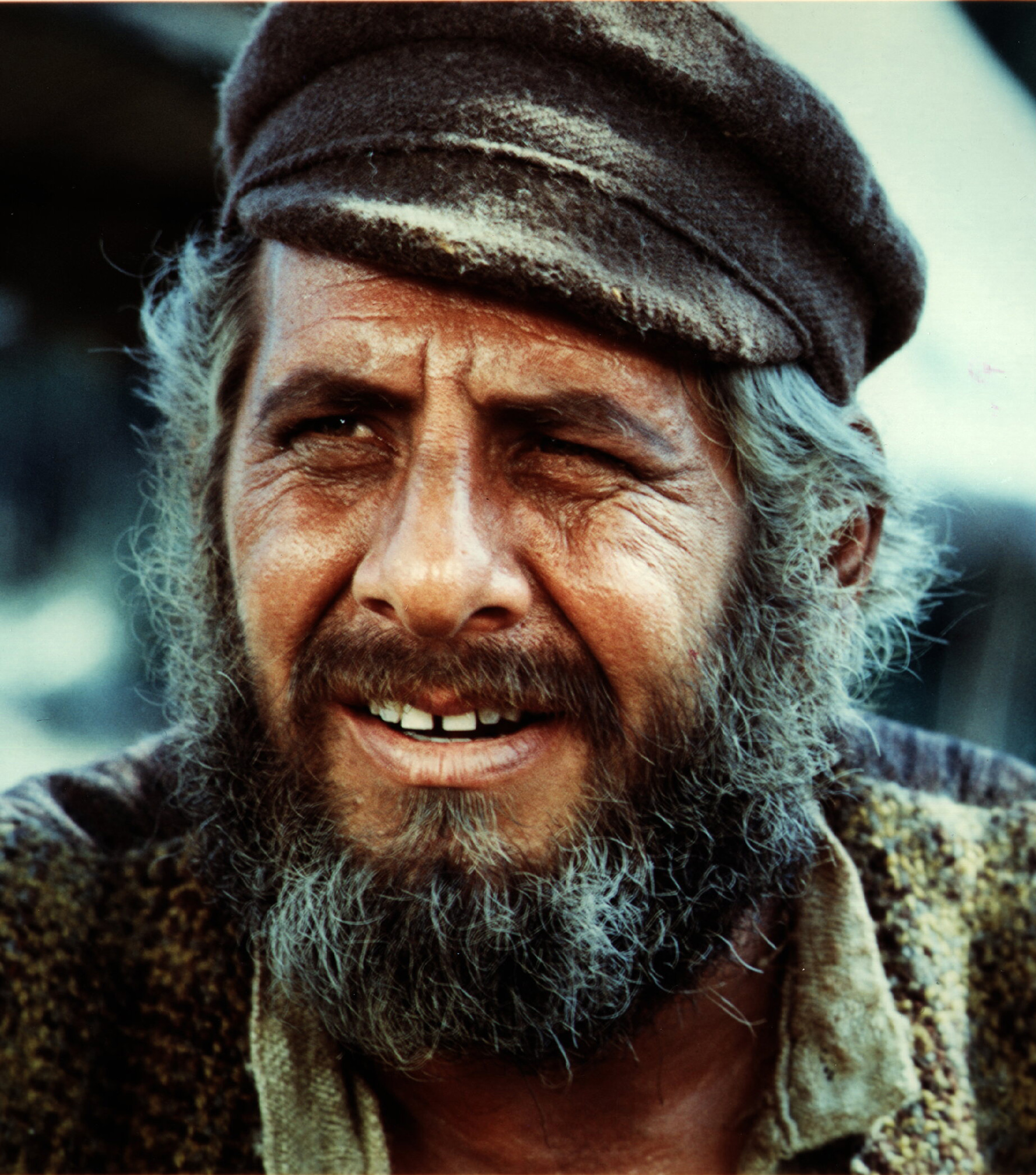
As Jason Diamond said, “Tevye is a style icon.” He’s referring, of course, to the milkman protagonist of “Tevye and his Daughters” by Sholom Aleichem and the star of the subsequent Broadway-turned-Hollywood musical “Fiddler on the Roof.”More than 50 years after the film’s release, “Fiddler” continues to shape our collective vision of shtetl life and fashion — courtesy of the tailor Motel Kamzoil. With his bushy gray beard, flat-topped hat (so iconic it became known as a fiddler cap) and wool vest, Tevye could be the prototype of the Brooklyn hipster.
“Yentl” (1983)
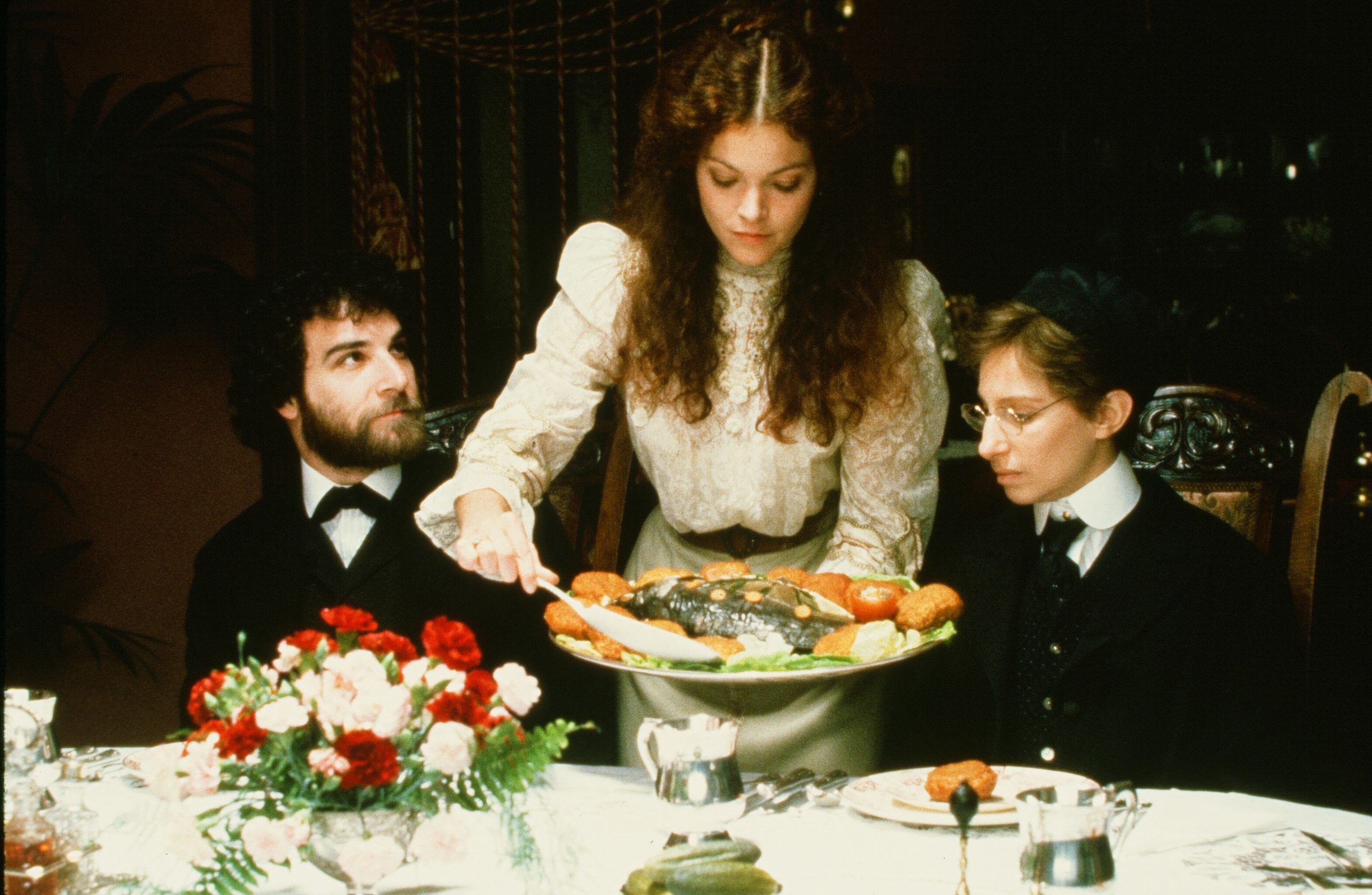
Based on a story by Isaac Bashevis Singer, “Yentl” opens like a fairy tale: “In a time when the world of study belonged only to men, there lived a girl called Yentl…” As with Cinderella and other fairy tale heroines, clothing is key to Yentl’s happily-ever-after. In Poland in 1904, Yentl’s unquenchable thirst for knowledge leads to a journey of self-transformation that begins when her father dies. We see her rending her garment at her father’s funeral (the practice known as kriah). After sitting shiva, she lifts the black cloth from the mirror and looks at herself. She picks up a pair of scissors and, in a sort of mirror image of the kriah, she cuts her long hair. (We know Babs can pull off a pixie cut after “Funny Girl.”) Dressed as a man, she takes on the name of her dead brother Anshel and runs away to join a yeshiva. Beyond the narrative importance of clothing, the film also presents a cornucopia of enviable menschwear. Dressed in their conservative clothing complete with kippahs and tallit, Yentl/Anshel and the other men at the yeshiva are frum but never frumpy. In a movie that is preoccupied with dressing and undressing, a standout moment occurs early in the story when Yentl secretly puts on her father’s tallis, silhouetted by candlelight, and stands before the mirror. She sings softly:
God, our merciful father,
I’m wrapped in a robe of light,
Clothed in your glory
That spreads its wings over my soul.
Maybe I be worthy
Amen.
“Hester Street” (1975)
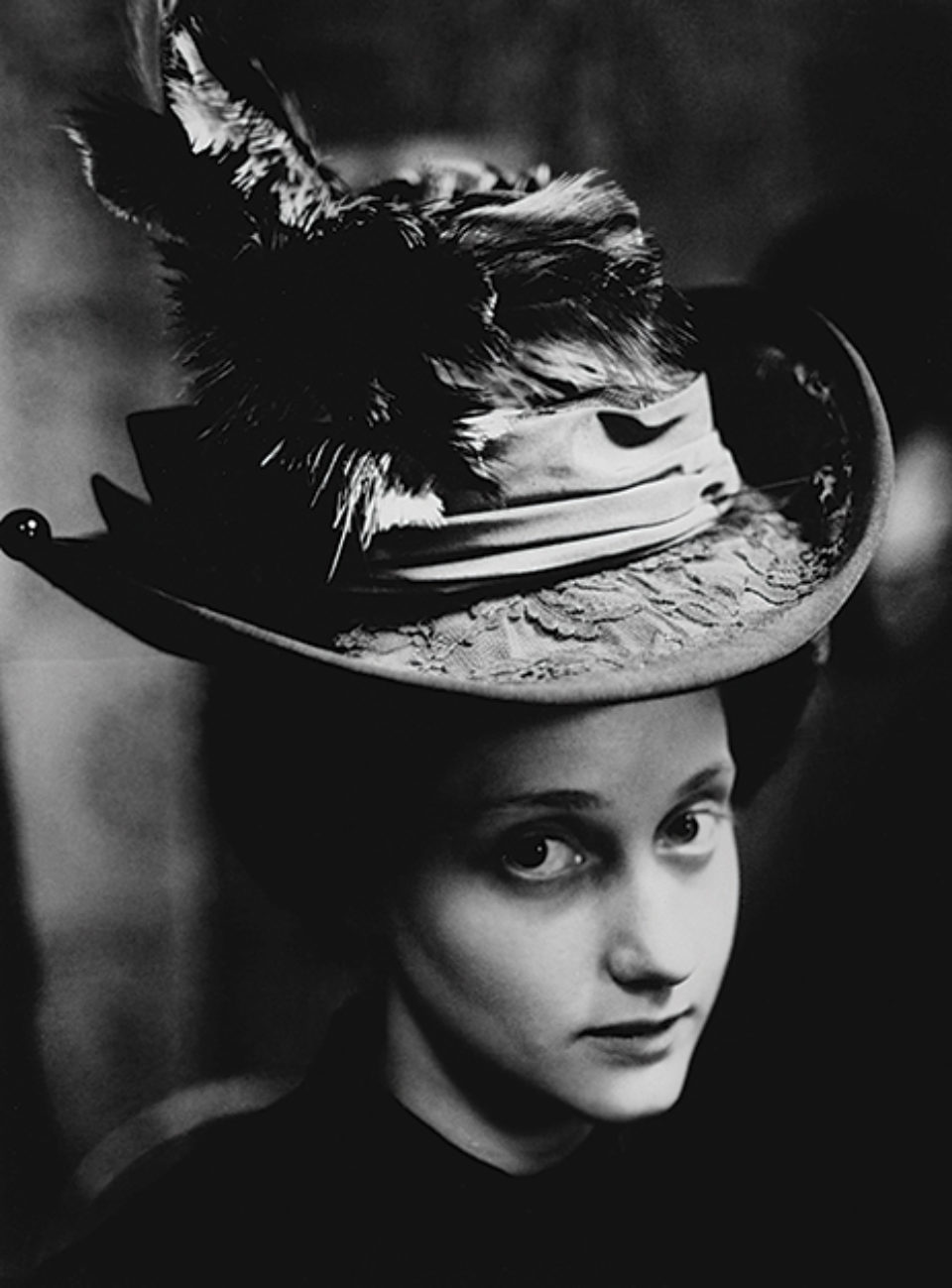
Joan Micklin Silver’s “Hester Street,” which was restored last year, brings us across the Atlantic to the epicenter of Jewish American fashion: ’90s New York City… the 1890s that is. The film opens with an introduction to Jake, a handsome young man about town, specifically the Lower East Side. Sporting a pinstripe suit, bowler hat and mustache, he’s a certified Yankee Doodle Dandy. Or rather a Yankel Doodle Dandy. Eastern European immigrant Yankel left his young bride and son behind in the old country while he got settled, and they’re finally joining him — much to the wannabe bachelor’s disappointment. As soon as Gitl (played by the luminous Carol Kane) arrives, Jake begins a relentless campaign to make her assimilate. He criticizes everything from the sheitel (wig) on her head to the Yiddish on her tongue, insisting she uncover her hair, dress less conservatively and learn English. But when Gitl does undergo a transformation, trading her dark, shapeless schmattes for a more cinched look with the help of a kind neighbor, the hypocritical nogoodnik Jake disparages her even more. It seems such modern attire is fine for his mistress but not for his wife. Much like Yentl, Gitl learns that dressing herself is an exercise in self-possession. And she has the hats to prove it.
“Rhoda” (1974-1978)
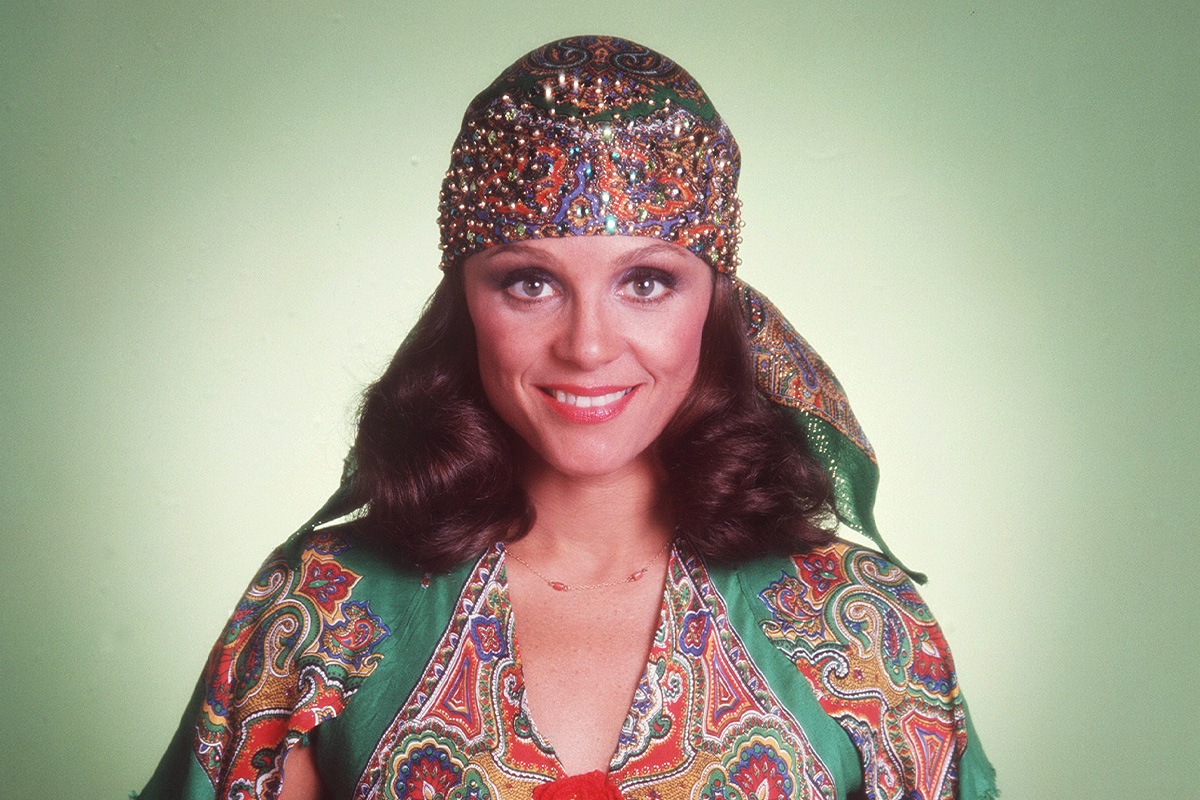
We can’t forget about Rhoda Morgenstern, the sassy Jewish BFF in the “Mary Tyler Moore Show” and star in the subsequent spinoff, “Rhoda,” played by non-Jewish Valerie Harper. Rhoda was known for rocking the headscarf, a 1970s boho spin on your great grandbubbe’s babushka. According to the gospel that is Vogue, the Old Testament accessory has been having yet another renaissance. Even pets are getting into it.
https://twitter.com/imjasondiamond/status/1572941027865944066
“Crossing Delancey” (1988)
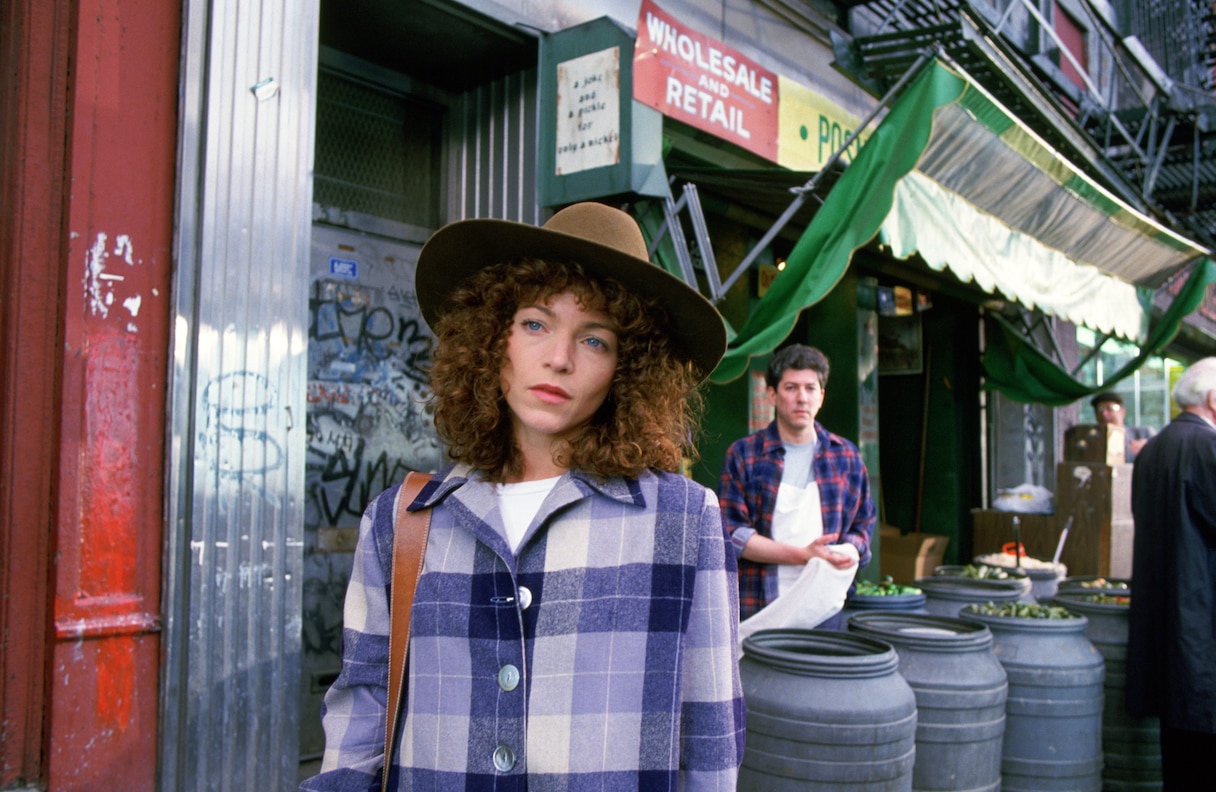
For a contemporary update on that heimish vibe, look no further than “Crossing Delancey,” from “Hester Street” writer-director Joan Micklin Silver. In her ranking for Hey Alma, Lana Schwartz called it “the best Jewish rom com of all time.” Heroine Izzy, played by familiar face Amy Irving, is a young bookseller caught between two worlds: Manhattan’s glitzy literary scene and the domain of her beloved bubbe on the Lower East Side. With her gorgeous curly mane and panache for pulling off millinery, Izzy could be the fully assimilated descendant of “Hester Street” Gitl. “Oh my God, it’s the return of Annie Hall,” Izzy’s friend quips when she sees her in a fabulous broad-brimmed Stetson hat, courtesy of the Nice Jewish Boy her bubbe has picked out for a shidduch. There are matchmaking mishaps and all the familiar trappings of the finest romantic comedy fare, here dressed in a distinctly Jewish fashion. I mean, a love interest who runs his late father’s pickle business? Tell me that’s not bashert.
“The Nanny” (1993-1999)
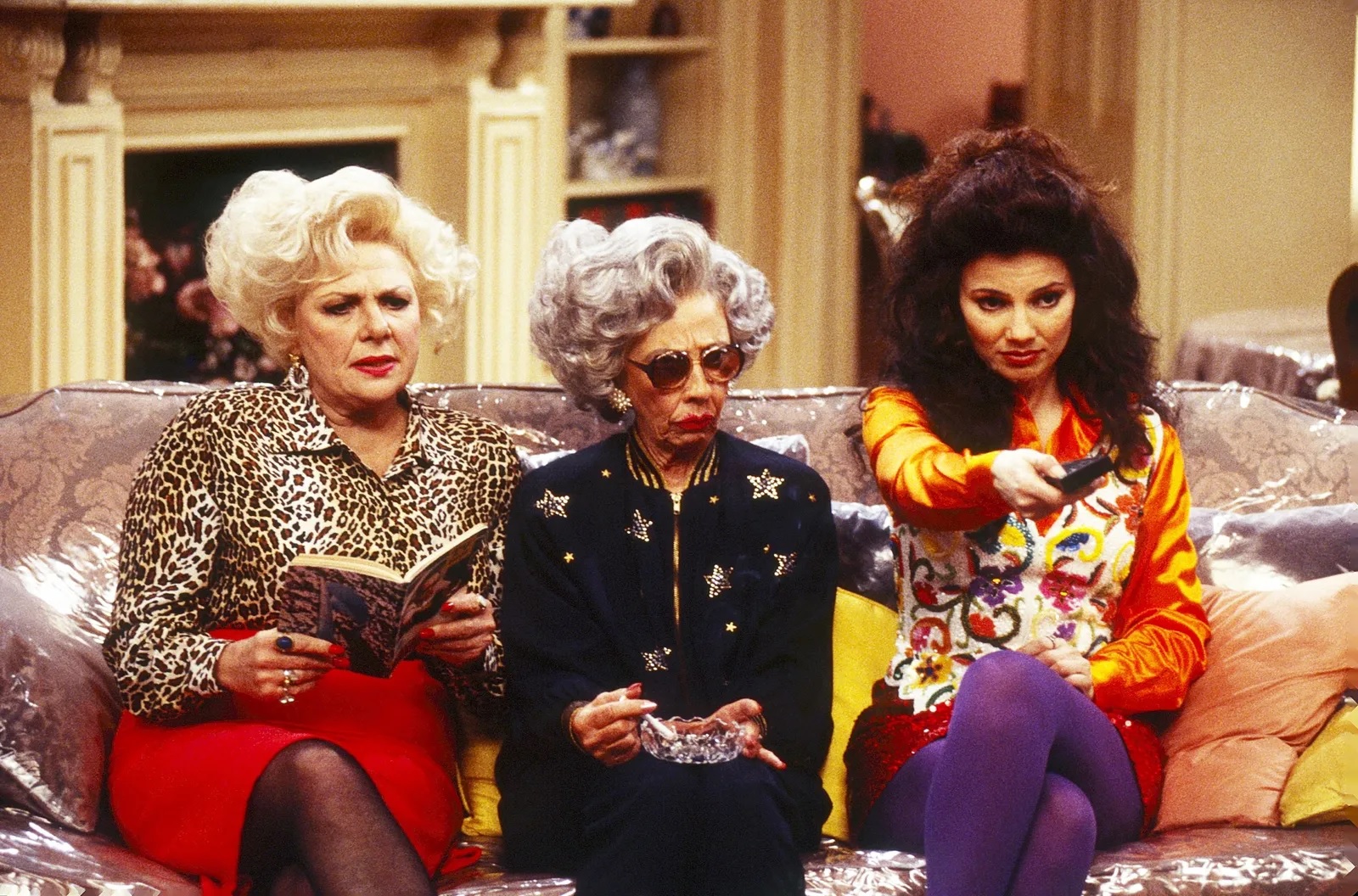
An entire monograph could be written on the “flashy girl from Flushing” and her unforgettable style. Fran Fine was one bold Drescher. Who else could pull off the most ungapatchka, over-the-top patterns, textures and hues, and make them look classic? Now that all six seasons of “The Nanny” are streaming on HBO Max, her look continues to make an impact. But for the purposes of Shtetlcore, it’s Grandma Yetta who we’re eager to emulate. With her blue-tinted hair, sequined jackets, bright velour tracksuits, fanny packs and coke-bottle glasses, Yetta takes Shtetlcore — and its sub-niche Bubbecore — and turns the amp up to 11. She breaks all the rules in the name of comfort and joyfulness. And that, in itself, is the essence of the shtetl: feeling at home wherever you are and whatever you’re wearing. Come to think of it, all of the Fine women, from Yetta to Sylvia to Fran and Aunt Frieda, are style icons. And they knew a good deal at Loehmann’s (RIP) when they saw one. By dressing the way we want to look instead of how we think we should, we become part of their meshuga mishpacha.
“An American Pickle” (2020)
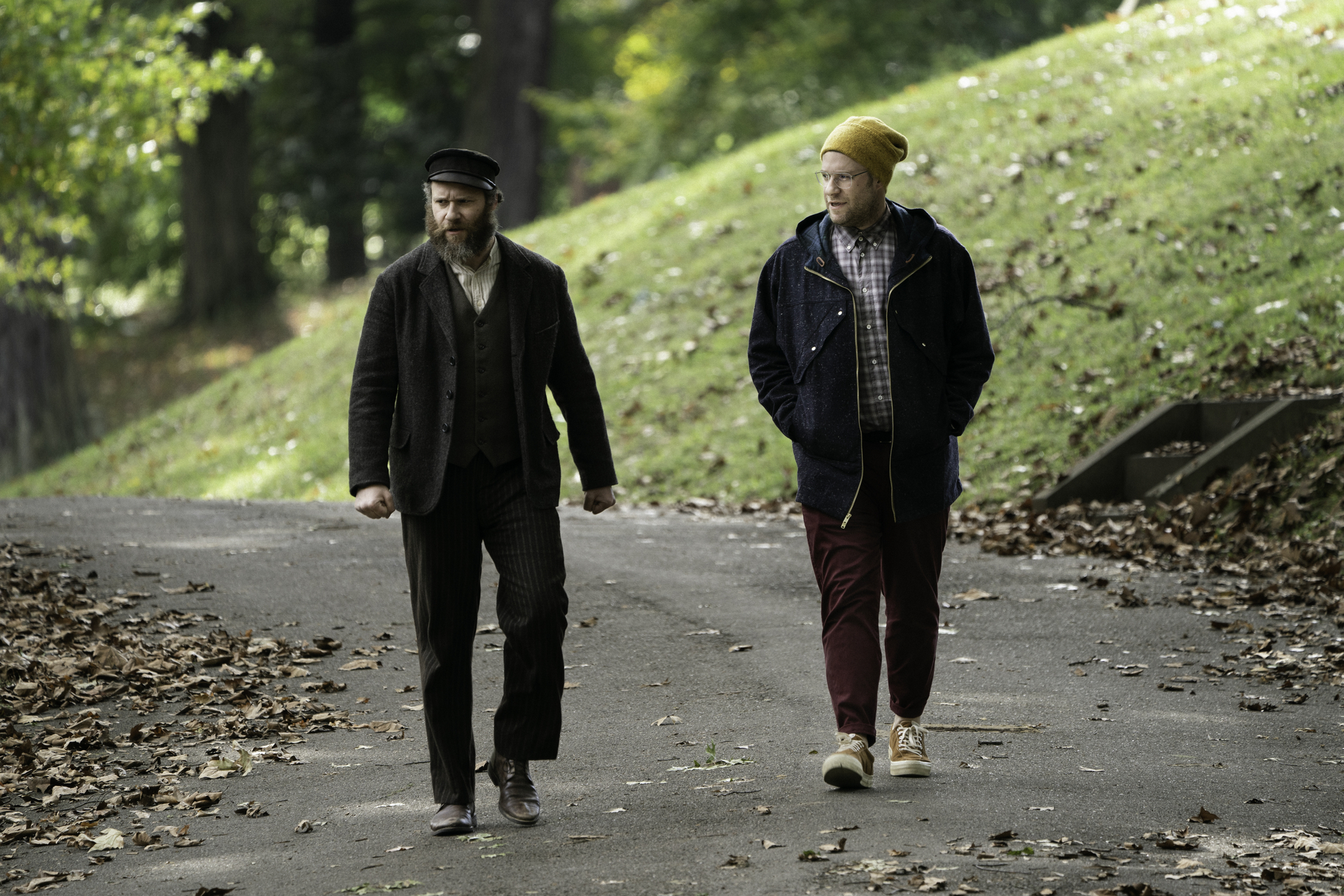
Our final Shtetlcore example brings us full circle, bridging the Old World and New. It’s the surreal comedy “An American Pickle,” based on a 2013 short story by Simon Rich, and starring the dill-lightful Seth Rogen in a dual role. (That’s right, more kosher pickles.) Rogen plays Herschel Greenbaum, a poor Jewish worker who flees the fictional Eastern European shtetl Schlupsk with his wife in 1919 after their home is pillaged by the Cossacks. In America, he finds a job at a pickle factory, where an unfortunate accident leaves him suspended in pickle brine. A century later, he wakes up in present-day Brooklyn. Enter Rogen’s second character, Herschel’s great-grandson Ben Greenbaum, who must teach this herring-out-of-water how to adapt to modern life. Complete with a fiddler cap, ample beard, tailored shirt and vest, pinstripe pants and cobbler-made shoes, Herschel’s look is very Tevye 2.0. (Or perhaps it’s a nod to the hero of the classic picture book “Herschel and the Hanukkah Goblins.”) Meanwhile, Herschel’s clean-shaven grandson’s look is decidedly more laidback, featuring a baseball cap or beanie and a rotation of cozy cardigans and jackets. (Layering skills seem to run in the family.) One thing’s for sure: In Brooklyn, everything old is Jew again.
Shtetlcore is more than just a cute and cozy fad. It encompasses our nostalgia for a lost way of life. Reclaiming the shtetl becomes a form of protest; we refuse to let our community and tradition be erased. If exile seems to be our Jewish birthright, then so is our ability to find and make a home wherever we are, beginning with the clothes on our backs.
